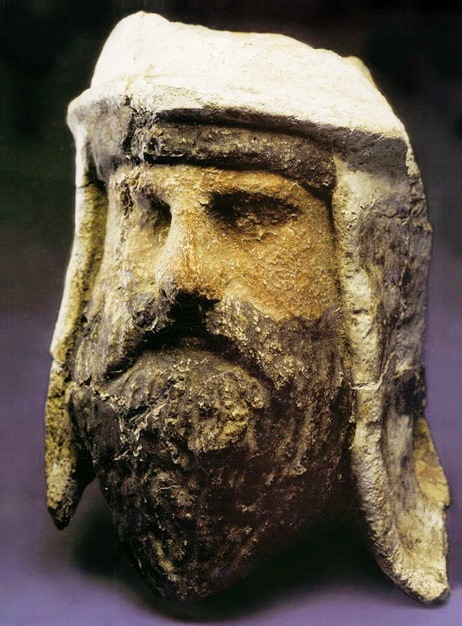
Painted clay and alabaster head of a Zoroastrian priest wearing a distinctive Bactrian-style headdress, Takhti-Sangin, Tajikistan, Greco-Bactrian kingdom, 3rd–2nd century BCE
Zoroastrianism or Mazdayasna is one of the world's oldest continuously practiced religions. It is a multi-tendency faith centered on a dualistic cosmology of good and evil and an eschatology predicting the ultimate conquest of evil with theological elements of henotheism, monotheism/monism, and polytheism.
Ascribed to the teachings of the Iranian-speaking spiritual leader Zoroaster (also known as Zarathushtra),it exalts an uncreated and benevolent deity of wisdom, Ahura Mazda (Wise Lord), as its supreme being.
Major features of Zoroastrianism, such as messianism, judgment after death, heaven and hell, and free will may have influenced other religious and philosophical systems, including Second Temple Judaism, Gnosticism, Greek philosophy, Christianity, Islam, the Bahá'í Faith, and Buddhism.
With possible roots dating back to the second millennium BCE, Zoroastrianism enters recorded history in the 5th century BCE.
Along with a Mithraic Median prototype and a Zurvanist Sassanid successor, it served as the state religion of the ancient Iranian empires for more than a millennium, from around 600 BCE to 650 CE. Zoroastrianism declined from the 7th century onwards following the Muslim conquest of Persia of 633–654.Recent estimates place the current number of Zoroastrians at around 110,000–120,000, with most living in India and in Iran; their number has been thought to be declining.
The most important texts of the religion are those of the Avesta, which includes as central the writings of Zoroaster known as the Gathas, enigmatic ritual poems that define the religion's precepts, which is within Yasna, the main worship service of modern Zoroastrianism. The religious philosophy of Zoroaster divided the early Iranian gods of the Proto-Indo-Iranian tradition into ahuras and daevas, the latter of which were not considered worthy of worship. Zoroaster proclaimed that Ahura Mazda was the supreme creator, the creative and sustaining force of the universe through Asha,and that human beings are given a right of choice between supporting Ahura Mazda or not, making them responsible for their choices. Though Ahura Mazda has no equal contesting force, Angra Mainyu (destructive spirit/mentality), whose forces are born from Aka Manah (evil thought), is considered the main adversarial force of the religion, standing against Spenta Mainyu (creative spirit/mentality). Middle Persian literature developed further Angra Mainyu into Ahriman and advancing him to be the direct adversary to Ahura Mazda.[
Asha (truth, cosmic order), the life force that originates from Ahura Mazda, stands in opposition to Druj (falsehood, deceit) and Ahura Mazda is considered to be all-good with no evil emanating from the deity.[Ahura Mazda works in gētīg (the visible material realm) and mēnōg (the invisible spiritual and mental realm) through the seven (six when excluding Spenta Mainyu) Amesha Spentas (direct emanations of Ahura Mazda) and the host of other Yazatas (literally meaning "worthy of worship"), who all worship Ahura Mazda in the Avesta and other texts and who Ahura Mazda requests worship towards in the same texts.
